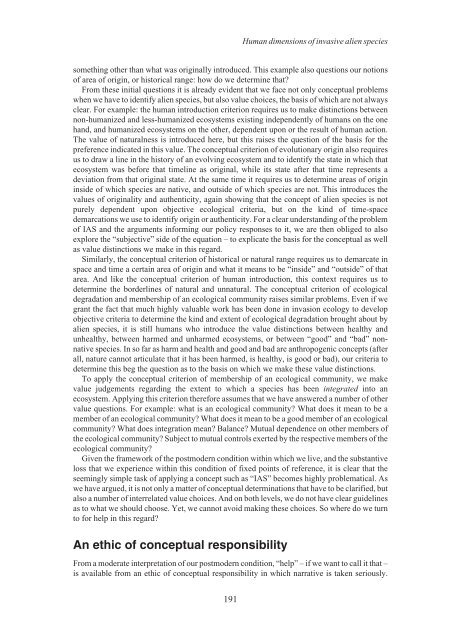Alien Species.vp - IUCN
Alien Species.vp - IUCN
Alien Species.vp - IUCN
You also want an ePaper? Increase the reach of your titles
YUMPU automatically turns print PDFs into web optimized ePapers that Google loves.
something other than what was originally introduced. This example also questions our notions<br />
of area of origin, or historical range: how do we determine that?<br />
From these initial questions it is already evident that we face not only conceptual problems<br />
when we have to identify alien species, but also value choices, the basis of which are not always<br />
clear. For example: the human introduction criterion requires us to make distinctions between<br />
non-humanized and less-humanized ecosystems existing independently of humans on the one<br />
hand, and humanized ecosystems on the other, dependent upon or the result of human action.<br />
The value of naturalness is introduced here, but this raises the question of the basis for the<br />
preference indicated in this value. The conceptual criterion of evolutionary origin also requires<br />
us to draw a line in the history of an evolving ecosystem and to identify the state in which that<br />
ecosystem was before that timeline as original, while its state after that time represents a<br />
deviation from that original state. At the same time it requires us to determine areas of origin<br />
inside of which species are native, and outside of which species are not. This introduces the<br />
values of originality and authenticity, again showing that the concept of alien species is not<br />
purely dependent upon objective ecological criteria, but on the kind of time-space<br />
demarcations we use to identify origin or authenticity. For a clear understanding of the problem<br />
of IAS and the arguments informing our policy responses to it, we are then obliged to also<br />
explore the “subjective” side of the equation – to explicate the basis for the conceptual as well<br />
as value distinctions we make in this regard.<br />
Similarly, the conceptual criterion of historical or natural range requires us to demarcate in<br />
space and time a certain area of origin and what it means to be “inside” and “outside” of that<br />
area. And like the conceptual criterion of human introduction, this context requires us to<br />
determine the borderlines of natural and unnatural. The conceptual criterion of ecological<br />
degradation and membership of an ecological community raises similar problems. Even if we<br />
grant the fact that much highly valuable work has been done in invasion ecology to develop<br />
objective criteria to determine the kind and extent of ecological degradation brought about by<br />
alien species, it is still humans who introduce the value distinctions between healthy and<br />
unhealthy, between harmed and unharmed ecosystems, or between “good” and “bad” nonnative<br />
species. In so far as harm and health and good and bad are anthropogenic concepts (after<br />
all, nature cannot articulate that it has been harmed, is healthy, is good or bad), our criteria to<br />
determine this beg the question as to the basis on which we make these value distinctions.<br />
To apply the conceptual criterion of membership of an ecological community, we make<br />
value judgements regarding the extent to which a species has been integrated into an<br />
ecosystem. Applying this criterion therefore assumes that we have answered a number of other<br />
value questions. For example: what is an ecological community? What does it mean to be a<br />
member of an ecological community? What does it mean to be a good member of an ecological<br />
community? What does integration mean? Balance? Mutual dependence on other members of<br />
the ecological community? Subject to mutual controls exerted by the respective members of the<br />
ecological community?<br />
Given the framework of the postmodern condition within which we live, and the substantive<br />
loss that we experience within this condition of fixed points of reference, it is clear that the<br />
seemingly simple task of applying a concept such as “IAS” becomes highly problematical. As<br />
we have argued, it is not only a matter of conceptual determinations that have to be clarified, but<br />
also a number of interrelated value choices. And on both levels, we do not have clear guidelines<br />
as to what we should choose. Yet, we cannot avoid making these choices. So where do we turn<br />
to for help in this regard?<br />
An ethic of conceptual responsibility<br />
From a moderate interpretation of our postmodern condition, “help” – if we want to call it that –<br />
is available from an ethic of conceptual responsibility in which narrative is taken seriously.<br />
191<br />
Human dimensions of invasive alien species












